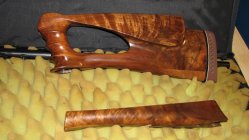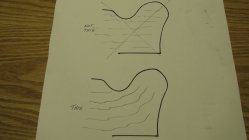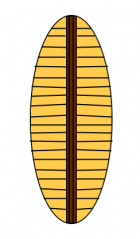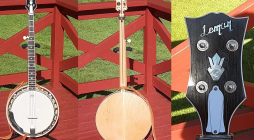How would one go about building a solid wood buttstock and forearm for a T/C Pro Hunter? My grandpa has one, and he has ofter talked about wanting another stock so he can use both his 7mm mag barrel and his .308 barrel without having to swap them on the same stock. I'd like to build him one of these.
You are using an out of date browser. It may not display this or other websites correctly.
You should upgrade or use an alternative browser.
You should upgrade or use an alternative browser.
Building a buttstock and forearm for T/C Pro Hunter
- Thread starter Blue20Boy17
- Start date
pdhntr
Silver $$ Contributor
How would one go about building a solid wood buttstock and forearm for a T/C Pro Hunter? My grandpa has one, and he has ofter talked about wanting another stock so he can use both his 7mm mag barrel and his .308 barrel without having to swap them on the same stock. I'd like to build him one of these.
I have made a couple for the older TC, not for the Pro Hunter, although it looks very similar to the older models.
I can probably help, however, I have to ask if you really want to do this?
1. It looks as though Stocky's has the Pro Hunter set (?) for about $100.
2. Your grandpa is not shooting a 223. Both of those recoil a good deal, and your design, choice of wood and grain flow is going to be extremely important, and there is no guarantee (after spending many hours of work) that it won't shatter at the wrist on the first shot.
Jim

Which direction should the grain run? Like, should the slab be flatsawn or quartersawn?I have made a couple for the older TC, not for the Pro Hunter, although it looks very similar to the older models.
I can probably help, however, I have to ask if you really want to do this?
1. It looks as though Stocky's has the Pro Hunter set (?) for about $100.
2. Your grandpa is not shooting a 223. Both of those recoil a good deal, and your design, choice of wood and grain flow is going to be extremely important, and there is no guarantee (after spending many hours of work) that it won't shatter at the wrist on the first shot.
JimView attachment 1213277
pdhntr
Silver $$ Contributor
That isn't as important as the "flow" of the grain. See my drawing.Which direction should the grain run? Like, should the slab be flatsawn or quartersawn?
There are two types of stocks for the TC. One of them is a thumbhole, the other is not. It is similar to my drawing. Which type are you thinking about building?
Jim

I was planning on doing the non-thumbhole one. I had an idea though (it may be a bad idea haha) about this. Would it "reinforce" the stock to do a lamination like this drawing? The drawing is a view from the end of the buttstock.That isn't as important as the "flow" of the grain. See my drawing.
There are two types of stocks for the TC. One of them is a thumbhole, the other is not. It is similar to my drawing. Which type are you thinking about building?
JimView attachment 1213441

pdhntr
Silver $$ Contributor
Yes, good idea. Walnut or were you thinking some other wood? If this is your first endeavor I would recommend Walnut.
All of my stocks are laminated. And it is usually easier to find Walnut boards than a blank with the grain running the way you need it.
My supplier is $10 a board foot, if he can find it. If you have a reasonable source of walnut, you might consider glueing up two blanks for the butt. Just in case the first doesn't go well.
Do you have access to a planer?
Jim
All of my stocks are laminated. And it is usually easier to find Walnut boards than a blank with the grain running the way you need it.
My supplier is $10 a board foot, if he can find it. If you have a reasonable source of walnut, you might consider glueing up two blanks for the butt. Just in case the first doesn't go well.
Do you have access to a planer?
Jim
a laminated piece of wood makes a good center lamination but does not look as good. I would agree that walnut is probably the best choice. Its easy to work especially if you find a straight grained piece. Maple is a good stock wood but can be a little difficult depending on the grain. Cherry is also a nice looking wood and easy to work in my opinion. Birch is also a good stock wood but super plain, though cheap.
You can buy boards at the home store but they are not necessarily the easiest to work with. If you laminate, you should try to get your boards flat. The thin lamination in your board might be able to flex a little if the glue faces are not perfectly flat. I prefer wood glue like titebond 2 or 3. I can get a flat joint and use miminal glue. Epoxy requires more glue and you need to be careful to over clamp it.
If you glue up a couple blanks, you can make a setup stock and a finish one. One thing to remember, its not how well you do, its how well you can repair any mistakes and make them look good.
You can buy boards at the home store but they are not necessarily the easiest to work with. If you laminate, you should try to get your boards flat. The thin lamination in your board might be able to flex a little if the glue faces are not perfectly flat. I prefer wood glue like titebond 2 or 3. I can get a flat joint and use miminal glue. Epoxy requires more glue and you need to be careful to over clamp it.
If you glue up a couple blanks, you can make a setup stock and a finish one. One thing to remember, its not how well you do, its how well you can repair any mistakes and make them look good.
I was going to use 3/8" walnut as the center lamination and curly maple for the rest. I have some absolutely beautiful curly maple.
I'm a banjo builder, and have worked with maple, walnut, and mahogany, as well as rosewood and ebony. I'm not extremely worried about workability, but this is my first gun stock. I realize gun stocks are a lot different from a banjo. That's why I was concerned about the grain flow, and why I decided to do a center lamination to hopefully fix any problems of stability. My first banjo was built with a center lamination, actually. It was straight-grain maple with a 1/8" walnut stripe.

I'm a banjo builder, and have worked with maple, walnut, and mahogany, as well as rosewood and ebony. I'm not extremely worried about workability, but this is my first gun stock. I realize gun stocks are a lot different from a banjo. That's why I was concerned about the grain flow, and why I decided to do a center lamination to hopefully fix any problems of stability. My first banjo was built with a center lamination, actually. It was straight-grain maple with a 1/8" walnut stripe.

Actually, a banjo neck may be tougher. With the string tension on instrument necks, the neck to pegged junction is similar to the stock wrist. Also you don't need to cut the neck-fretboard interface to prevent string buzz.
Take the old stock off and cut the inlet the same, to fit the action and barrel. Then remove everything that doesn't belong. I have never done a 2 piece stock but one piece gun stocks are actually pretty easy. I think on the 2 piece, the difficulty lies in if you have drill a long straight hole for the stock bolt. Other than that, I think it should be pretty straightforward.
Take the old stock off and cut the inlet the same, to fit the action and barrel. Then remove everything that doesn't belong. I have never done a 2 piece stock but one piece gun stocks are actually pretty easy. I think on the 2 piece, the difficulty lies in if you have drill a long straight hole for the stock bolt. Other than that, I think it should be pretty straightforward.
Dusty Stevens
Shiner
Nothing to add here except i love your workI was going to use 3/8" walnut as the center lamination and curly maple for the rest. I have some absolutely beautiful curly maple.
I'm a banjo builder, and have worked with maple, walnut, and mahogany, as well as rosewood and ebony. I'm not extremely worried about workability, but this is my first gun stock. I realize gun stocks are a lot different from a banjo. That's why I was concerned about the grain flow, and why I decided to do a center lamination to hopefully fix any problems of stability. My first banjo was built with a center lamination, actually. It was straight-grain maple with a 1/8" walnut stripe.
View attachment 1213493
pdhntr
Silver $$ Contributor
I was going to use 3/8" walnut as the center lamination and curly maple for the rest. I have some absolutely beautiful curly maple.
I'm a banjo builder, and have worked with maple, walnut, and mahogany, as well as rosewood and ebony. I'm not extremely worried about workability, but this is my first gun stock. I realize gun stocks are a lot different from a banjo. That's why I was concerned about the grain flow, and why I decided to do a center lamination to hopefully fix any problems of stability. My first banjo was built with a center lamination, actually. It was straight-grain maple with a 1/8" walnut stripe.
I have never built a banjo so I can relate, and the pics show your woodworking skills are not lacking. Very impressive. That is good to know as it will likely help us to move on quickly. Sounds like the "stakes" will be high on this one. Good challenge.
One of the first things you have to do is get the woods glued together and drying. I am assuming you can measure out what your need including excess to be trimmed later and so on. I think your 3/8" center lam is good. I am assuming you have a glue that works for you, I use Titebond only because I can get it locally in gallons at a good price and it has worked for me.
What is important is that when glueing everything up, you realize you are introducing a lot of moisture to the wood, especially the walnut as it will soak up more moisture than the maple. As you know, the wood is going to expand slightly at the glue line. I have had some shrinkage show up if I worked the blank too quickly after laminating.
This shrinkage showed up at the glue lines after it was finished. It wasn't a big deal and was noticed only by me, but I decided to glue up my blanks at least 6 months before use. I am sure you want to get at this sooner, and it could be just fine in this situation, but if you see some shifting in the future, that is the reason.
The laminates should be flat on the sides they meet. If they aren't perfectly flat, you will introduce stress to the stock that may show up as you remove material. You are working with a two piece stock so this is not such a big deal, but if you can get them to fit together without warp, twist or cup all the better. I start with rough cut lumber, so I have to use a planer sled to perfectly flatten one side, before I reverse it and send it back through.
So far so good?
Jim
You probably know this but,with the exception of "dry" hide glue flakes,modern glue has a shelf life. That's one concern with buying by the gallon.
Another kinda funny glue thing is. It doesn't matter how "clear" a glue is..... once it's in a line,between two pieces.... it isn't "clear" anymore. There's no light from the inside,so all glue lines mostly appear dark to black in color on finished product. You can actually use these "lines" as thin color stripes. An example would be a, maple/maple/walnut. The / lines in that example are "black" color stripes. They show up on light colored wood,not so much on walnut. Use accordingly.
Another kinda funny glue thing is. It doesn't matter how "clear" a glue is..... once it's in a line,between two pieces.... it isn't "clear" anymore. There's no light from the inside,so all glue lines mostly appear dark to black in color on finished product. You can actually use these "lines" as thin color stripes. An example would be a, maple/maple/walnut. The / lines in that example are "black" color stripes. They show up on light colored wood,not so much on walnut. Use accordingly.
Similar threads
- Replies
- 2
- Views
- 310
Upgrades & Donations
This Forum's expenses are primarily paid by member contributions. You can upgrade your Forum membership in seconds. Gold and Silver members get unlimited FREE classifieds for one year. Gold members can upload custom avatars.

Click Upgrade Membership Button ABOVE to get Gold or Silver Status.
You can also donate any amount, large or small, with the button below. Include your Forum Name in the PayPal Notes field.
To DONATE by CHECK, or make a recurring donation, CLICK HERE to learn how.

Click Upgrade Membership Button ABOVE to get Gold or Silver Status.
You can also donate any amount, large or small, with the button below. Include your Forum Name in the PayPal Notes field.
To DONATE by CHECK, or make a recurring donation, CLICK HERE to learn how.









